Exploring the Spatiotemporal Impacts of the Built Environment on Taxi Ridership Using Multisource Data
Abstract
:1. Introduction
2. Literature Review
2.1. Factors Affecting Transit Ridership
2.2. Methodologies
2.2.1. Global Perspective
2.2.2. Spatial and Temporal Perspective
3. Study Area and Data
3.1. Study Area
3.2. Data Description and Preprocessing
4. Materials and Methods
4.1. Explanatory Variables
4.2. Multicollinearity
4.3. Spatiotemporal Nonstationarity
4.4. Regression Models
5. Results and Discussion
5.1. Travel Patterns Comparison
5.2. Model Results
5.3. Temporal Features
5.4. Spatial Features
5.4.1. Density of Railway Stations
5.4.2. Entropy of POIs
5.4.3. Accessibility of the Built Environment
6. Conclusions and Policy Implications
- (1)
- People travel time and distance by taxi become longer the farther the origin TAZs are from the downtown. On weekdays, the average travel distance is 0.13 miles shorter than on weekends, but the average travel time is 2.3 min longer. For transit modes, there is a positive correlation between the railway and taxi ridership on weekdays, whereas it is negative on weekends. Buses have little impact on taxi ridership over the week. Moreover, bicycles have some role in reducing the taxi ridership.
- (2)
- In the downtown areas of the city, the density of public facilities, educational institutions, tourist facilities, and parking sites is positively associated with the demand for taxis, while health institutions and railway stations are negatively associated with it most of the time. The high density of accommodation and trunk road network increase taxi demand only during the daily peak period, while high bus stop accessibility and road network accessibility reduce taxi trips during the peak time.
- (3)
- Land use entropy significantly affects the travel behavior, with the highly mixed function reducing taxi ridership. However, highly mixed transportation hardly works in it. A highly mixed degree of transportation can only reduce taxi ridership in remote areas with underdeveloped public transportation, while in downtown areas it increases the taxi ridership.
- (4)
- Low-accessibility road network increases off-peak and evening peak taxi ridership and reduces it during the morning peak period, indicating that people think highly of travel time during weekday morning rush hours. In addition, in areas prone to congestion or longer travel times, low-accessibility road networks are more likely to reduce the demand for taxi trips. On average, the accessibility of the road network has a negative correlation with taxi ridership.
- (1)
- At the present stage, most taxis prefer to carry passengers in central Manhattan, resulting in an uneven taxi distribution within the city. Our study found that a highly accessible road network increases people’s willingness to take taxis in the outer parts of the downtown, while in most parts of the central downtown, a highly accessible road network always results in a lower taxi travel demand. Taxi companies can take advantage of this feature to increase taxi deployment to parts of the downtown periphery during off-peak hours, and it is possible to increase the revenue of the taxi companies while maintaining a balance between the supply and demand of taxis between different urban districts.
- (2)
- As far as we know, in areas with well-developed transportation, travel time by subway is similar to and less costly than that offered by taxi. However, our study shows that in downtown areas, taxis are more irreplaceable in the morning peak hours than in the evening peak hours and on weekends, meaning that people prefer to spend more on transportation to ensure an efficient commute. Therefore, if the transfer between residential areas and railway stations is more convenient, people may reduce their reliance on taxis in the morning peak hours, which will also have a positive effect on alleviating the traffic congestion. As a result, the government can improve this situation by equipping convenient transfer services, such as developing MaaS (Mobility as a Service), improving the transfer infrastructure between shared bicycles and railway stations, or providing well-equipped park-and-ride facilities around the stations [45].
- (3)
- Contrary to our perception, in general, offering a variety of transportation options has had little to no effect on reducing the taxi ridership, but has largely increased it, especially in downtown areas. However, larger variety of transit options may be effective in reducing taxi ridership in some remote areas where people travel for longer distances and at higher costs. The government could lighten the travel burden for residents by equipping them with convenient facilities of diverse transit modes in these districts. In addition, we believe that the essence of the solution to this problem lies in developing these remote areas with diverse land functions, which can fundamentally reduce the people’s travel time and travel distance and at the same time reduce the taxi influx to the downtown from these areas.
- (4)
- As analyzed in this paper, the positive correlation between the density of POIs for people’s spatiotemporal travel and taxi ridership is roughly consistent, such as people commuting between their workplace and residence on weekdays and mainly engaging in leisure and recreational activities on weekends, which increase the taxi ridership at some specific time of the day. Therefore, these relevant spatiotemporal hotspots can be equipped with convenient, esthetically pleasing, and orderly cabstands to enhance people’s travel experience during peak periods.
Author Contributions
Funding
Institutional Review Board Statement
Informed Consent Statement
Data Availability Statement
Acknowledgments
Conflicts of Interest
Appendix A
| Explanatory Variable | MIN | LQ | MED | UQ | MAX |
|---|---|---|---|---|---|
| Public | −4700.84 | −1.94 | 0.00 | 3.54 | 13,254.00 |
| Leisure | −11,957.69 | −2.81 | 0.14 | 3.40 | 25,248.38 |
| Shopping | −15,614.50 | −0.72 | −0.01 | 0.57 | 608.00 |
| Tourism | −27,648.00 | −1.48 | 0.16 | 3.46 | 33,195.50 |
| Education | −6912.00 | −2.28 | −0.10 | 3.56 | 1439.14 |
| Health | −6912.00 | −2.05 | 0.08 | 3.05 | 224,952.00 |
| Accommodation | −55,029.00 | −5.00 | 0.00 | 5.25 | 19,514.00 |
| Worship | −5280.00 | −2.03 | 0.00 | 2.91 | 9131.75 |
| Taxi | −1,013,776.00 | −25.89 | 2.78 | 38.40 | 3,223,703.00 |
| Bus | −359.31 | −0.72 | 0.02 | 0.75 | 1316.54 |
| Railway | −5187.00 | −8.70 | −0.20 | 5.02 | 77,434.50 |
| Parking | −308,660.00 | −4.71 | 0.54 | 12.45 | 22,072.74 |
| Bicycle | −54282.00 | −0.47 | 0.07 | 0.94 | 4960.00 |
| Other | −585,032.00 | −57.39 | −2.56 | 12.65 | 705,660.00 |
| Trunk road network density | −111.43 | −2.54 | 0.00 | 1.91 | 5621.38 |
| Railway network density | −24,027.75 | −7.97 | 0.58 | 10.22 | 68,537.00 |
| Traffic signal density | −904.00 | −0.25 | 0.05 | 0.90 | 1585.41 |
| Land use entropy | −27,777.13 | −25.00 | −0.64 | 5.70 | 759.26 |
| Transport entropy | −19,684.75 | −15.50 | 0.10 | 25.79 | 22,070.00 |
| Bus stop accessibility | −6042.88 | −0.32 | 0.15 | 0.92 | 5170.72 |
| Road network accessibility | −793.29 | −4.80 | 0.00 | 2.66 | 450.56 |
| Explanatory Variable | MIN | LQ | MED | UQ | MAX |
|---|---|---|---|---|---|
| Public | −2461.65 | −2.47 | 0.00 | 2.94 | 1956.94 |
| Leisure | −1059.13 | −2.27 | 0.41 | 4.89 | 1752.94 |
| Shopping | −1964.19 | −0.88 | −0.04 | 0.59 | 2555.51 |
| Tourism | −23,282.25 | −1.63 | 0.26 | 2.80 | 18,818.95 |
| Education | −1176.50 | −2.76 | −0.08 | 3.39 | 3006.29 |
| Health | −9643.46 | −2.53 | 0.00 | 2.35 | 6328.18 |
| Accommodation | −8453.22 | −5.89 | 0.00 | 5.36 | 7023.74 |
| Worship | −1472.50 | −1.57 | 0.09 | 4.01 | 2253.11 |
| Taxi | −8,597,000.00 | −16.00 | 8.00 | 48.00 | 9,123,000.00 |
| Bus | −167.66 | −0.72 | 0.02 | 1.07 | 262.34 |
| Railway | −12,697.70 | −12.83 | −0.91 | 3.44 | 1599.92 |
| Parking | −10,323.40 | −6.10 | 0.08 | 9.64 | 32,130.99 |
| Bicycle | −1784.69 | −0.47 | 0.10 | 0.98 | 1579.45 |
| Other | −704,512.00 | −70.90 | −3.40 | 14.50 | 174,186.00 |
| Trunk road network density | −441.35 | −3.46 | −0.05 | 1.10 | 313.19 |
| Railway network density | −2963.90 | −6.88 | 0.46 | 12.91 | 10,454.38 |
| Traffic signal density | −271.84 | −0.26 | 0.06 | 0.82 | 177.75 |
| Land use entropy | −2357.49 | −38.69 | −1.81 | 3.49 | 665.80 |
| Transport entropy | −993.82 | −9.05 | 1.00 | 34.33 | 12,449.50 |
| Bus stop accessibility | −789.97 | −0.20 | 0.23 | 1.48 | 731.02 |
| Road network accessibility | −3953.55 | −3.56 | −0.04 | 0.96 | 4009.29 |
| Explanatory Variable | Weekdays | Weekends | ||
|---|---|---|---|---|
| Morning Peak (7 am–10 am) | Evening Peak (5 pm–8 pm) | Noon Peak (12 pm–3 pm) | Evening Peak (5 pm–8 pm) | |
| Public | −3.23 | −4.63 | −1.72 | 6.02 |
| Leisure | −5.89 | 31.66 | 0.94 | 0.81 |
| Shopping | 0.37 | −7.75 | −1.24 | 5.46 |
| Tourism | −4.41 | 55.07 | 5.00 | 28.82 |
| Education | 1.62 | 0.43 | −1.50 | 10.91 |
| Health | −1.94 | 10.95 | 1.05 | −30.40 |
| Accommodation | 2.48 | 23.01 | 5.64 | 21.10 |
| Worship | −2.43 | 7.14 | 2.88 | −5.11 |
| Taxi | 282.71 | −66.80 | 31.41 | −108.54 |
| Bus | −0.77 | 0.94 | 0.27 | 0.74 |
| Railway | −2.04 | 0.10 | −1.71 | −38.97 |
| Parking | 7.34 | −16.01 | −16.66 | −7.44 |
| Bicycle | 0.91 | −15.62 | −0.86 | −2.46 |
| Other | −20.26 | 1037.86 | 20.28 | 332.58 |
| Trunk road network density | 2.02 | 1.33 | −2.31 | −4.11 |
| Railway network density | 4.75 | −42.14 | −5.97 | 16.82 |
| Traffic signal density | 0.50 | 2.96 | 0.92 | 0.18 |
| Land use entropy | −60.90 | −95.37 | −56.08 | −74.33 |
| Transport entropy | 1.76 | 39.92 | 24.41 | 57.01 |
| Bus stop accessibility | 0.37 | 4.86 | 1.17 | −0.62 |
| Road network accessibility | 1.71 | −9.19 | −0.96 | −14.79 |
References
- Ma, X.; Zhang, J.; Ding, C.; Wang, Y. A Geographically and Temporally Weighted Regression Model to Explore the Spatiotemporal Influence of Built Environment on Transit Ridership. Comput. Environ. Urban Syst. 2018, 70, 113–124. [Google Scholar] [CrossRef]
- Shen, X.; Zhou, Y.; Jin, S.; Wang, D. Spatiotemporal Influence of Land Use and Household Properties on Automobile Travel Demand. Transp. Res. Part D Transp. Environ. 2020, 84, 102359. [Google Scholar] [CrossRef]
- Qian, X.; Ukkusuri, S.V. Spatial Variation of the Urban Taxi Ridership Using GPS Data. Appl. Geogr. 2015, 59, 31–42. [Google Scholar] [CrossRef]
- Tang, J.; Gao, F.; Liu, F.; Zhang, W.; Qi, Y. Understanding Spatio-Temporal Characteristics of Urban Travel Demand Based on the Combination of GWR and GLM. Sustainability 2019, 11, 5525. [Google Scholar] [CrossRef] [Green Version]
- Chen, C.; Feng, T.; Ding, C.; Yu, B.; Yao, B. Examining the Spatial-Temporal Relationship between Urban Built Environment and Taxi Ridership: Results of a Semi-Parametric GWPR Model. J. Transp. Geogr. 2021, 96, 103172. [Google Scholar] [CrossRef]
- Liu, Q.; Ding, C.; Chen, P. A Panel Analysis of the Effect of the Urban Environment on the Spatiotemporal Pattern of Taxi Demand. Travel Behav. Soc. 2020, 18, 29–36. [Google Scholar] [CrossRef]
- Hochmair, H.H. Spatiotemporal Pattern Analysis of Taxi Trips in New York City. Transp. Res. Rec. 2016, 2542, 45–56. [Google Scholar] [CrossRef]
- Tang, J.; Zhu, Y.; Huang, Y.; Peng, Z.-R.; Wang, Z. Identification and Interpretation of Spatial–Temporal Mismatch between Taxi Demand and Supply Using Global Positioning System Data. J. Intell. Transp. Syst. 2019, 23, 403–415. [Google Scholar] [CrossRef]
- Ni, Y.; Chen, J. Exploring the Effects of the Built Environment on Two Transfer Modes for Metros: Dockless Bike Sharing and Taxis. Sustainability 2020, 12, 2034. [Google Scholar] [CrossRef] [Green Version]
- Ewing, R. Is Los Angeles-Style Sprawl Desirable? J. Am. Plan. Assoc. 1997, 63, 107–126. [Google Scholar] [CrossRef]
- Ewing, R.; Tian, G.; Lyons, T. Does Compact Development Increase or Reduce Traffic Congestion? Cities 2018, 72, 94–101. [Google Scholar] [CrossRef] [Green Version]
- Horváth, M.T.; Mátrai, T.; Tóth, J. Route Planning Methodology with Four-Step Model and Dynamic Assignments. Transp. Res. Procedia 2017, 27, 1017–1025. [Google Scholar] [CrossRef]
- Chen, E.; Ye, Z.; Wang, C.; Zhang, W. Discovering the Spatio-Temporal Impacts of Built Environment on Metro Ridership Using Smart Card Data. Cities 2019, 95, 102359. [Google Scholar] [CrossRef]
- Ewing, R.; Cervero, R. Travel and the Built Environment: A Meta-Analysis. J. Am. Plan. Assoc. 2010, 76, 265–294. [Google Scholar] [CrossRef]
- Egu, O.; Bonnel, P. How Comparable Are Origin-Destination Matrices Estimated from Automatic Fare Collection, Origin-Destination Surveys and Household Travel Survey? An Empirical Investigation in Lyon. Transp. Res. Part A Policy Pract. 2020, 138, 267–282. [Google Scholar] [CrossRef]
- Bian, R.; Wilmot, C.G.; Wang, L. Estimating Spatio-Temporal Variations of Taxi Ridership Caused by Hurricanes Irene and Sandy: A Case Study of New York City. Transp. Res. Part D Transp. Environ. 2019, 77, 627–638. [Google Scholar] [CrossRef]
- Tracy, A.J.; Su, P.; Sadek, A.W.; Wang, Q. Assessing the Impact of the Built Environment on Travel Behavior: A Case Study of Buffalo, New York. Transportation 2011, 38, 663–678. [Google Scholar] [CrossRef]
- Ma, X.; Ji, Y.; Yuan, Y.; Van Oort, N.; Jin, Y.; Hoogendoorn, S. A Comparison in Travel Patterns and Determinants of User Demand between Docked and Dockless Bike-Sharing Systems Using Multisourced Data. Transp. Res. Part A Policy Pract. 2020, 139, 148–173. [Google Scholar] [CrossRef]
- Yu, H.; Peng, Z.-R. The Impacts of Built Environment on Ridesourcing Demand: A Neighbourhood Level Analysis in Austin, Texas. Urban Stud. 2020, 57, 152–175. [Google Scholar] [CrossRef]
- De Abreu e Silva, J.; Morency, C.; Goulias, K.G. Using Structural Equations Modeling to Unravel the Influence of Land Use Patterns on Travel Behavior of Workers in Montreal. Transp. Res. Part A Policy Pract. 2012, 46, 1252–1264. [Google Scholar] [CrossRef]
- Yu, L.; Xie, B.; Chan, E. How Does the Built Environment Influence Public Transit Choice in Urban Villages in China? Sustainability 2018, 11, 148. [Google Scholar] [CrossRef] [Green Version]
- Sabouri, S.; Park, K.; Smith, A.; Tian, G.; Ewing, R. Exploring the Influence of Built Environment on Uber Demand. Transp. Res. Part D Transp. Environ. 2020, 81, 102296. [Google Scholar] [CrossRef]
- Huang, G.; Qiao, S.; Yeh, A.G.-O. Spatiotemporally Heterogeneous Willingness to Ridesplitting and Its Relationship with the Built Environment: A Case Study in Chengdu, China. Transp. Res. Part C Emerg. Technol. 2021, 133, 103425. [Google Scholar] [CrossRef]
- Hawkins, J.; Nurul Habib, K. Travel Distance and Land Use: A Generalized Box–Cox Model with Conditional Spatial Lag Dependence. Transp. A Transp. Sci. 2021, 17, 1101–1121. [Google Scholar] [CrossRef]
- Wang, S.; Yu, D.; Ma, X.; Xing, X. Analyzing Urban Traffic Demand Distribution and the Correlation between Traffic Flow and the Built Environment Based on Detector Data and POIs. Eur. Transp. Res. Rev. 2018, 10, 50. [Google Scholar] [CrossRef]
- Yu, H.; Peng, Z.-R. Exploring the Spatial Variation of Ridesourcing Demand and Its Relationship to Built Environment and Socioeconomic Factors with the Geographically Weighted Poisson Regression. J. Transp. Geogr. 2019, 75, 147–163. [Google Scholar] [CrossRef]
- Huang, B.; Wu, B.; Barry, M. Geographically and Temporally Weighted Regression for Modeling Spatio-Temporal Variation in House Prices. Int. J. Geogr. Inf. Sci. 2010, 24, 383–401. [Google Scholar] [CrossRef]
- GaWC. The World According to GaWC 2020; GaWC: Leicestershire, UK, 2020. [Google Scholar]
- Shannon, C.; Weaver, W. The Mathematical Theory of Communication; The University of Illinois Press: Champaign, IL, USA, 1964; 131p. [Google Scholar]
- Zeng, S.; Yang, P.; Fang, D. Accessibility Assessment on Structure of Street Network. J. Tongji Univ. Nat. Sci. Ed. 2001, 29, 666–672. [Google Scholar]
- Wu, H.; Levinson, D. Unifying Access. Transp. Res. Part D Transp. Environ. 2020, 83, 102355. [Google Scholar] [CrossRef]
- Hansen, W.G. How Accessibility Shapes Land Use. J. Am. Inst. Plan. 1959, 25, 73–76. [Google Scholar] [CrossRef]
- El-Geneidy, A.; Grimsrud, M.; Wasfi, R.; Tétreault, P.; Surprenant-Legault, J. New Evidence on Walking Distances to Transit Stops: Identifying Redundancies and Gaps Using Variable Service Areas. Transportation 2014, 41, 193–210. [Google Scholar] [CrossRef]
- Gutiérrez, J.; García-Palomares, J.C. Distance-Measure Impacts on the Calculation of Transport Service Areas Using GIS. Environ. Plan. B Plan. Des. 2008, 35, 480–503. [Google Scholar] [CrossRef]
- Fotheringham, A.S.; Brunsdon, C.; Charlton, M. Geographically Weighted Regression: The Analysis of Spatially Varying Relationships; John Wiley & Sons: Hoboken, NJ, USA, 2002; ISBN 978-0-471-49616-8. [Google Scholar]
- Fotheringham, A.S.; Crespo, R.; Yao, J. Geographical and Temporal Weighted Regression (GTWR): Geographical and Temporal Weighted Regression. Geogr. Anal. 2015, 47, 431–452. [Google Scholar] [CrossRef] [Green Version]
- Lei, F. Travel Intensity Influencing Factors Analysis Model Based on Signaling Data. J. Transp. Syst. Eng. Inf. Technol. 2020, 20, 51–55. [Google Scholar]
- Brunsdon, C.; Fotheringham, A.S.; Charlton, M.E. Geographically Weighted Regression: A Method for Exploring Spatial Nonstationarity. Geogr. Anal. 2010, 28, 281–298. [Google Scholar] [CrossRef]
- Gollini, I.; Lu, B.; Charlton, M.; Brunsdon, C.; Harris, P. GWmodel: An R Package for Exploring Spatial Heterogeneity Using Geographically Weighted Models. J. Stat. Soft. 2015, 63, 1–50. [Google Scholar] [CrossRef] [Green Version]
- Lu, B.; Harris, P.; Charlton, M.; Brunsdon, C. The GWmodel R Package: Further Topics for Exploring Spatial Heterogeneity Using Geographically Weighted Models. Geo-Spat. Inf. Sci. 2014, 17, 85–101. [Google Scholar] [CrossRef]
- Li, Y.; Xiong, W.; Wang, X. Does Polycentric and Compact Development Alleviate Urban Traffic Congestion? A Case Study of 98 Chinese Cities. Cities 2019, 88, 100–111. [Google Scholar] [CrossRef]
- Xie, C.; Yu, D.; Zheng, X.; Wang, Z.; Jiang, Z. Revealing Spatiotemporal Travel Demand and Community Structure Characteristics with Taxi Trip Data: A Case Study of New York City. PLoS ONE 2021, 16, e0259694. [Google Scholar] [CrossRef]
- Ulak, M.B.; Yazici, A.; Aljarrah, M. Value of Convenience for Taxi Trips in New York City. Transp. Res. Part A Policy Pract. 2020, 142, 85–100. [Google Scholar] [CrossRef]
- Zhang, X.; Xu, Y.; Tu, W.; Ratti, C. Do Different Datasets Tell the Same Story about Urban Mobility—A Comparative Study of Public Transit and Taxi Usage. J. Transp. Geogr. 2018, 70, 78–90. [Google Scholar] [CrossRef]
- Zheng, L.; Xie, Z.; Ding, T.; Xi, J.; Meng, F. Parking and Ride Induction Methods for Drivers in Commuting Scenes. Symmetry 2021, 13, 2176. [Google Scholar] [CrossRef]
- Lu, B.; Charlton, M.; Harris, P.; Fotheringham, A.S. Geographically Weighted Regression with a Non-Euclidean Distance Metric: A Case Study Using Hedonic House Price Data. Int. J. Geogr. Inf. Sci. 2014, 28, 660–681. [Google Scholar] [CrossRef]
- Lu, B.; Brunsdon, C.; Charlton, M.; Harris, P. Geographically Weighted Regression with Parameter-Specific Distance Metrics. Int. J. Geogr. Inf. Sci. 2017, 31, 982–998. [Google Scholar] [CrossRef] [Green Version]
- Yu, H.; Fotheringham, A.S.; Li, Z.; Oshan, T.; Kang, W.; Wolf, L.J. Inference in Multiscale Geographically Weighted Regression. Geogr. Anal. 2020, 52, 87–106. [Google Scholar] [CrossRef]
- Fotheringham, A.S.; Yang, W.; Kang, W. Multiscale Geographically Weighted Regression (MGWR). Ann. Am. Assoc. Geogr. 2017, 107, 1247–1265. [Google Scholar] [CrossRef]
- Wu, C.; Ren, F.; Hu, W.; Du, Q. Multiscale Geographically and Temporally Weighted Regression: Exploring the Spatiotemporal Determinants of Housing Prices. Int. J. Geogr. Inf. Sci. 2019, 33, 489–511. [Google Scholar] [CrossRef]

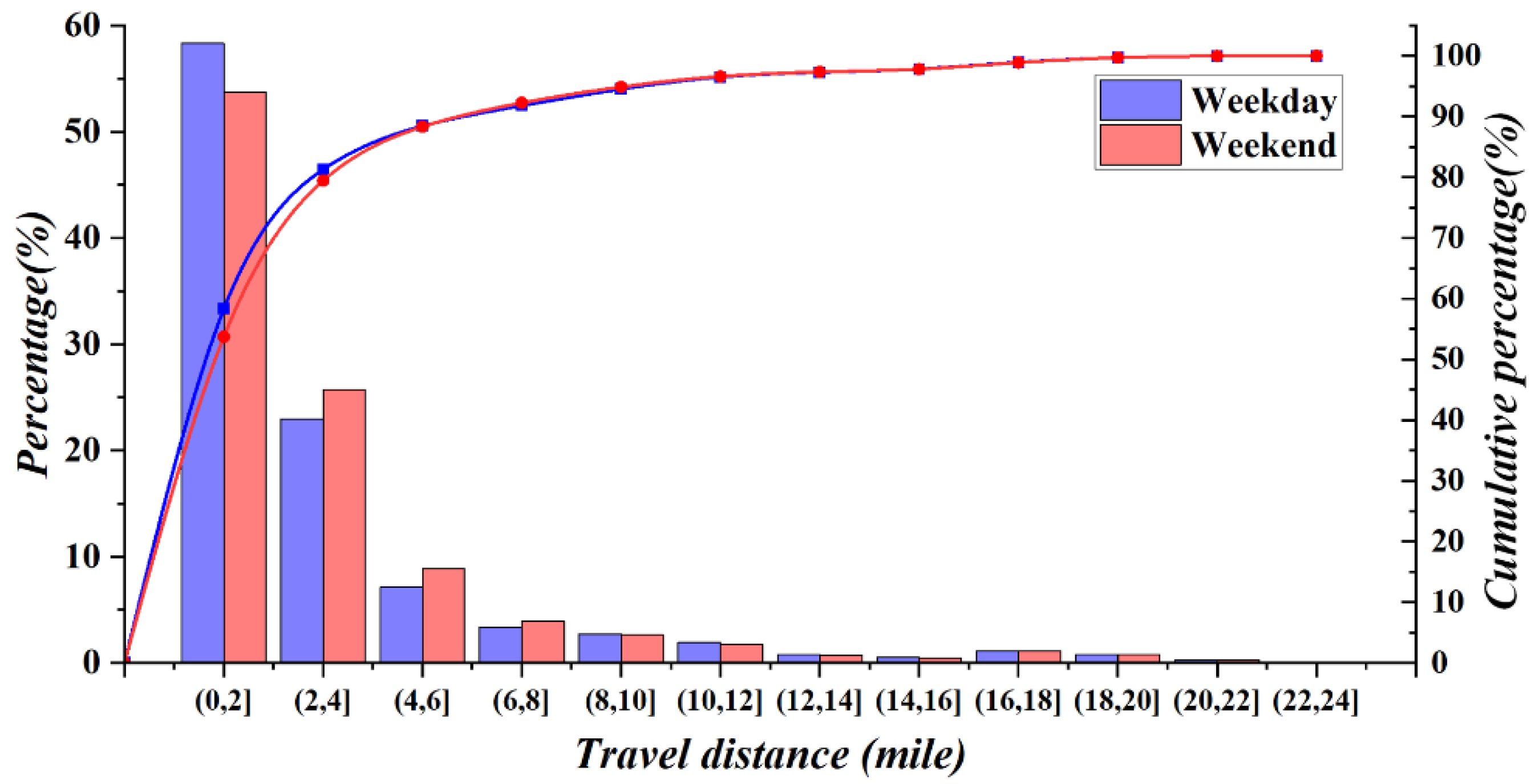
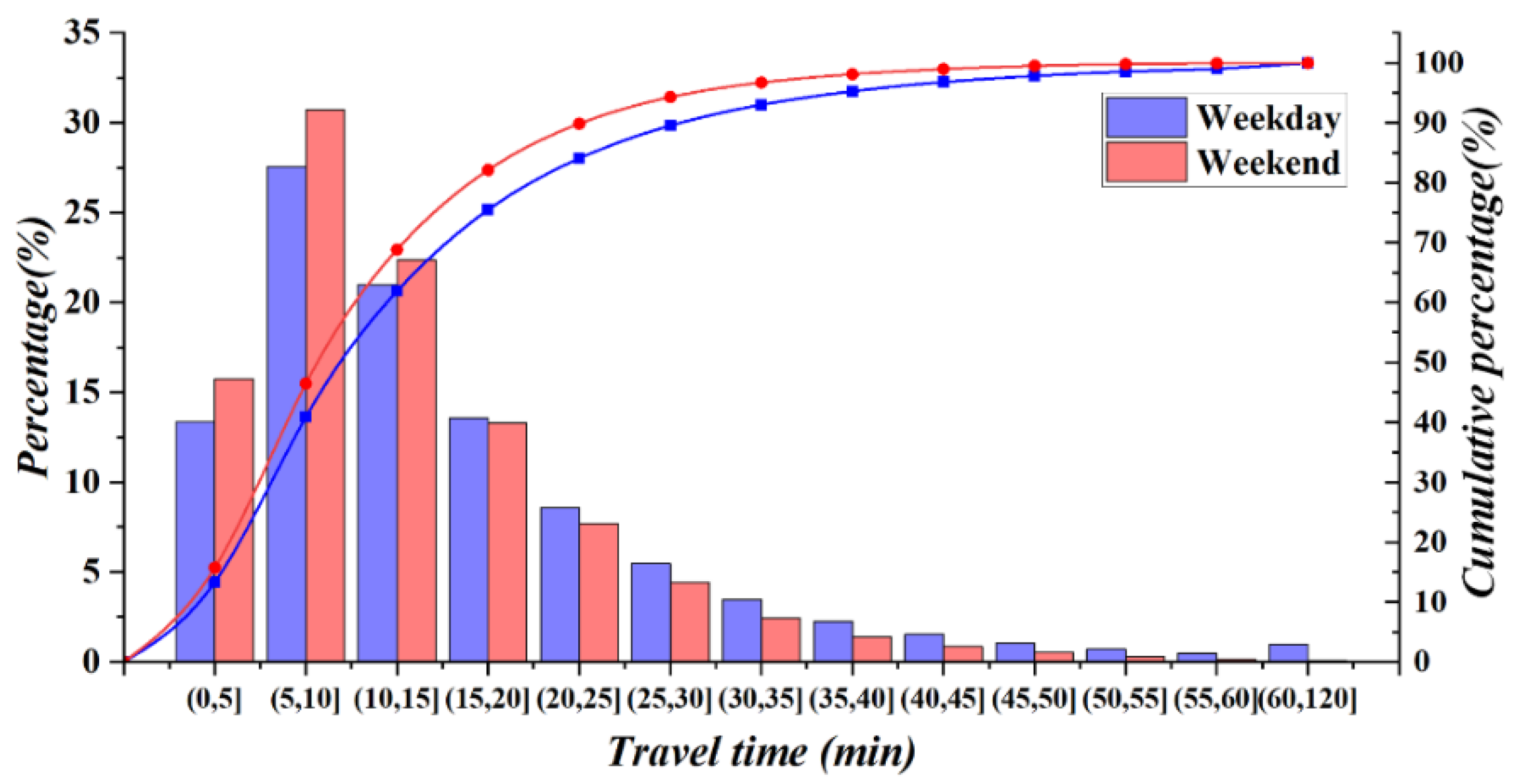
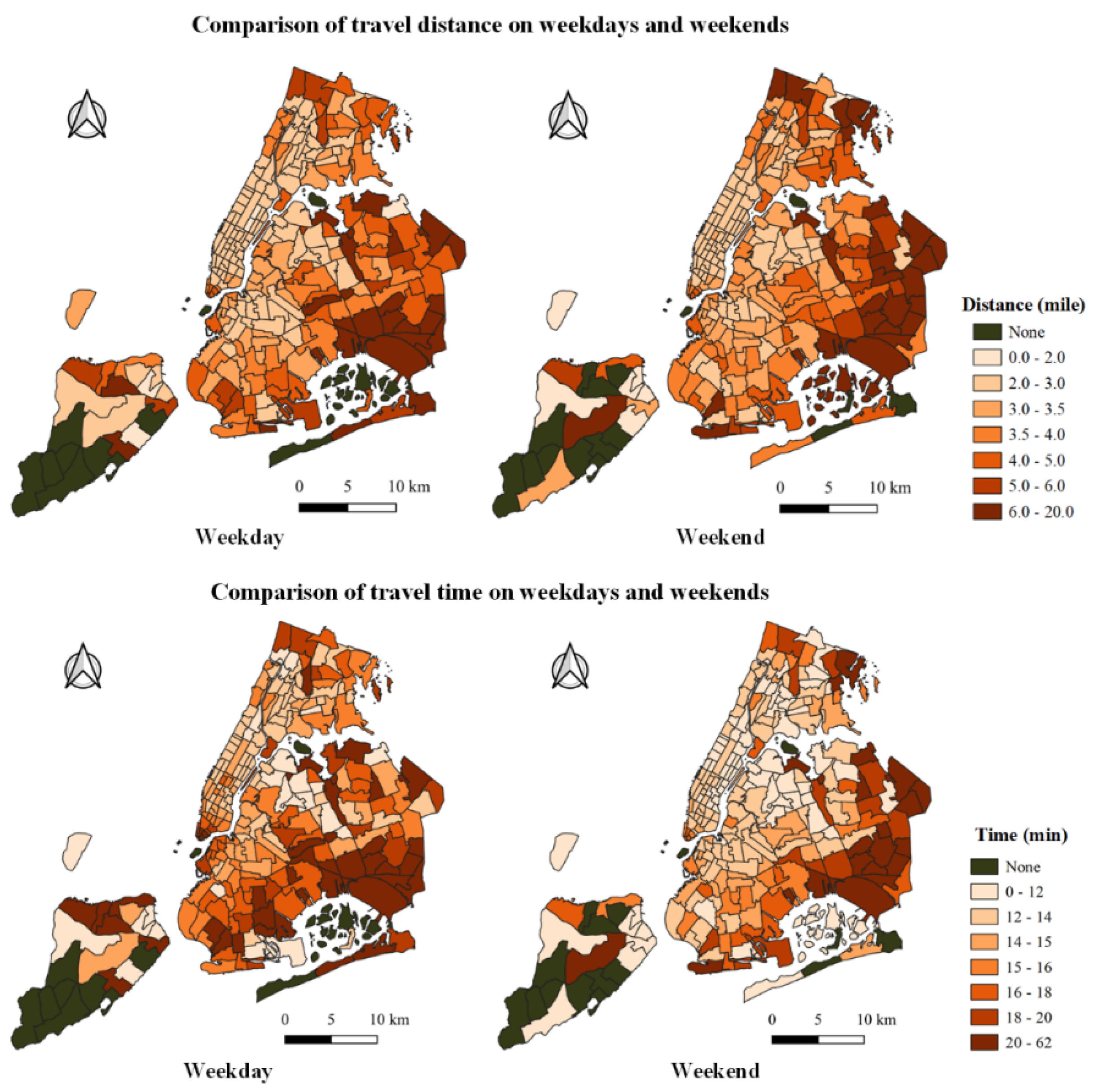

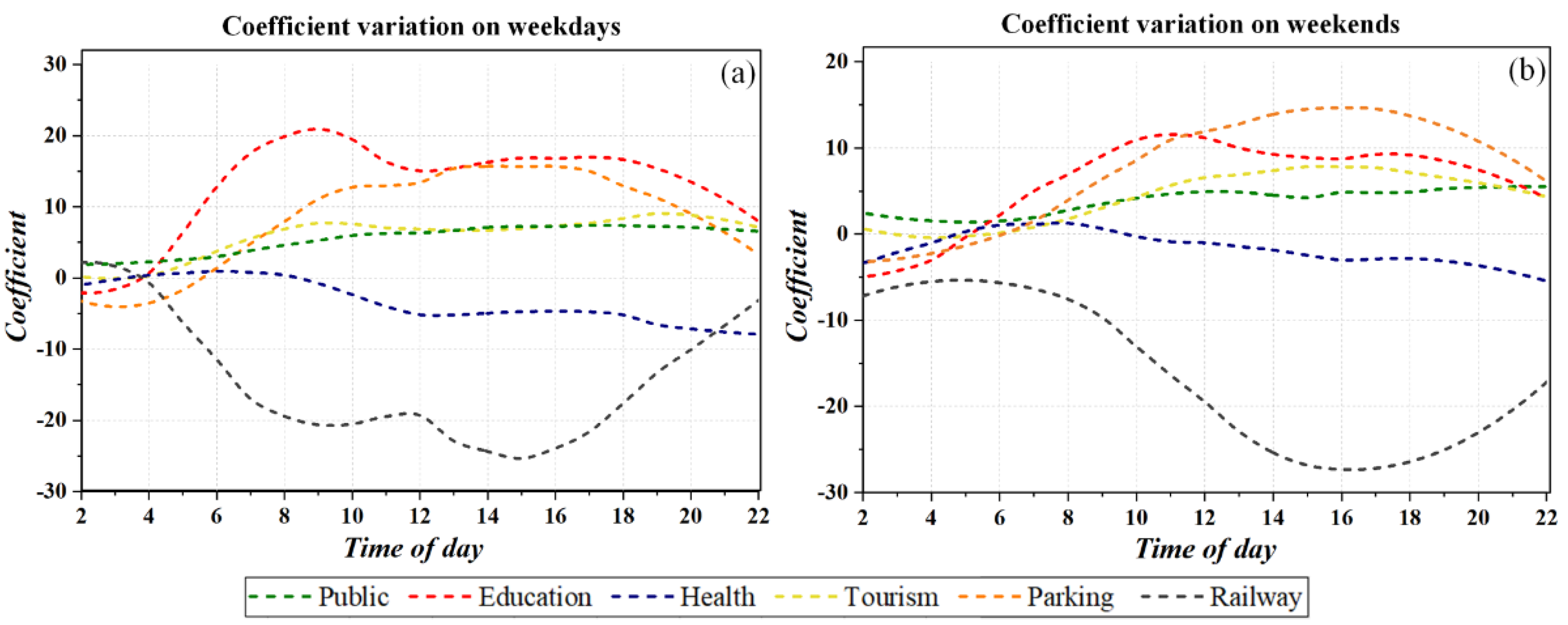
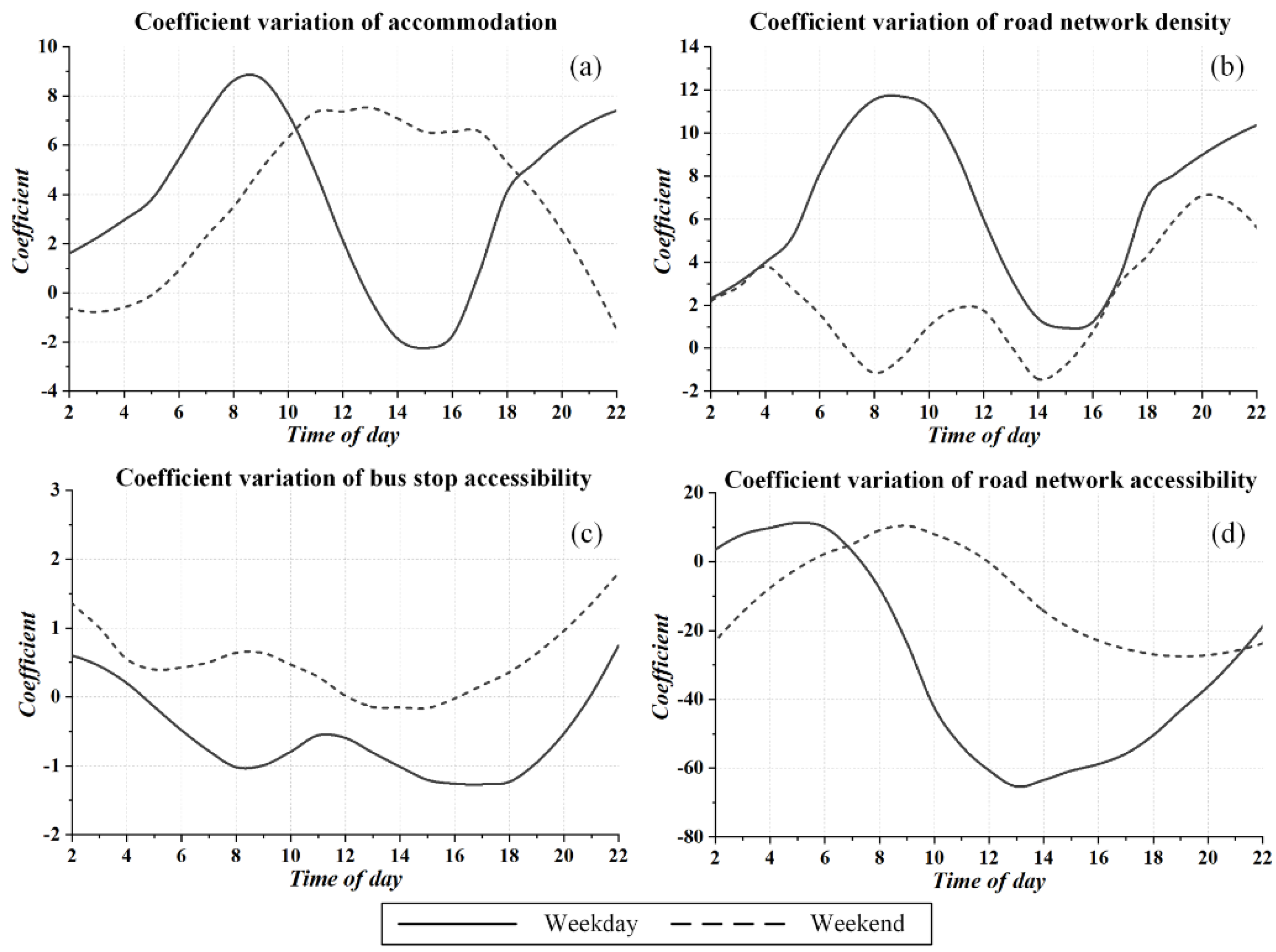
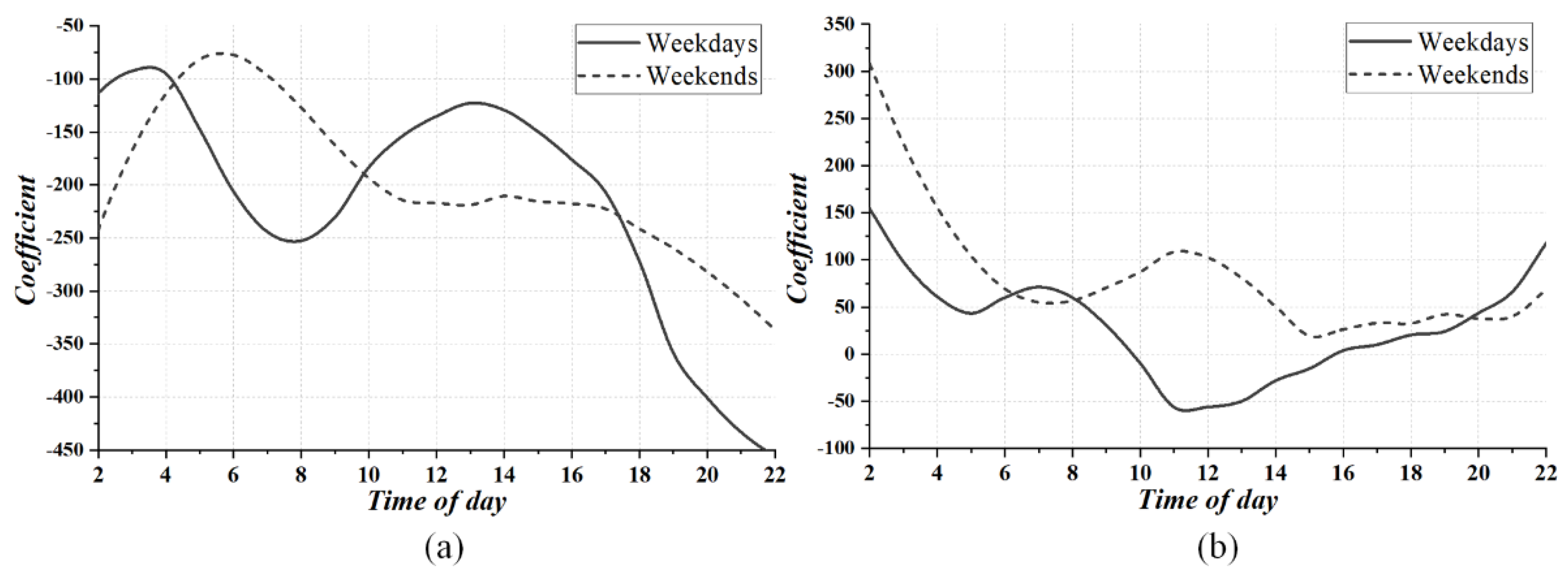
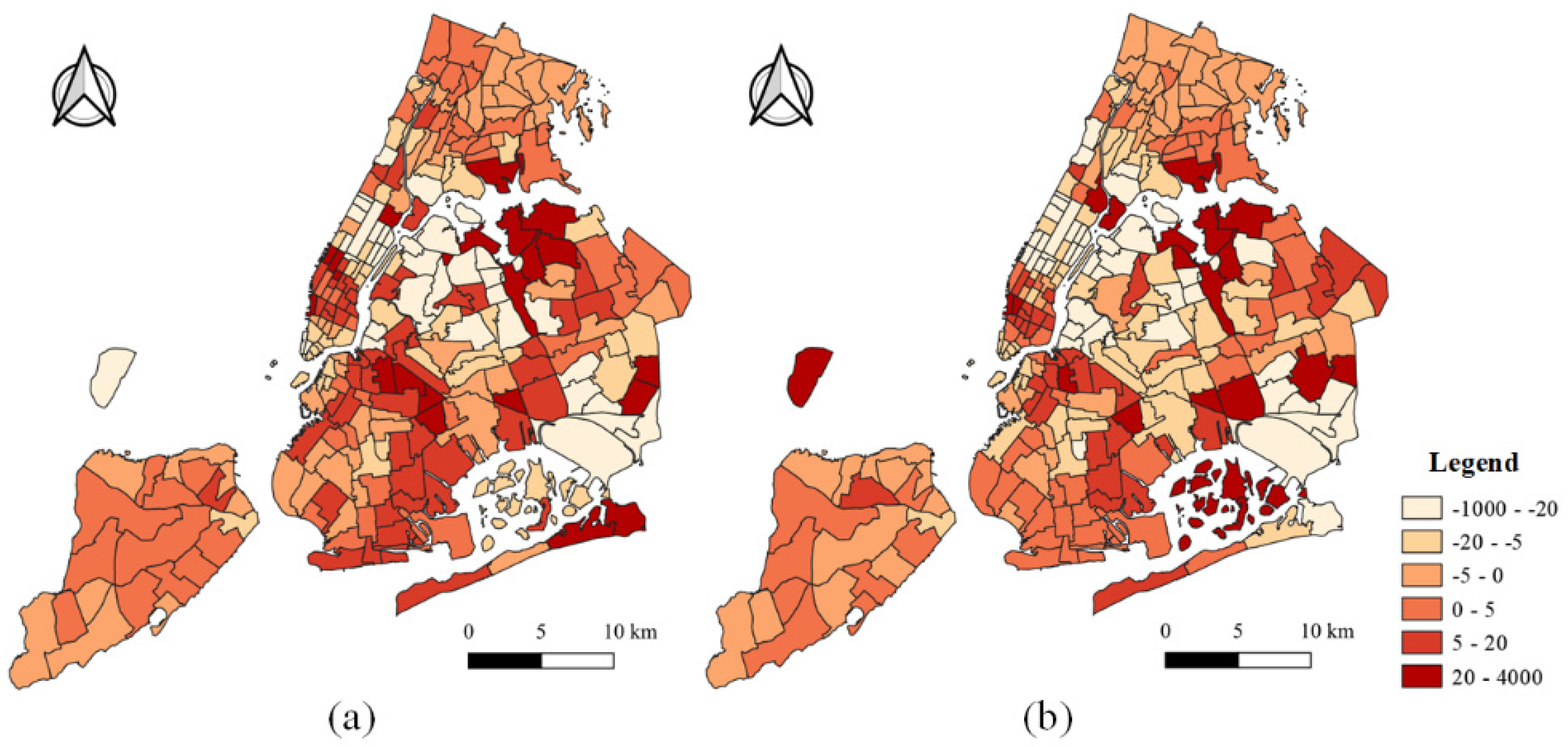
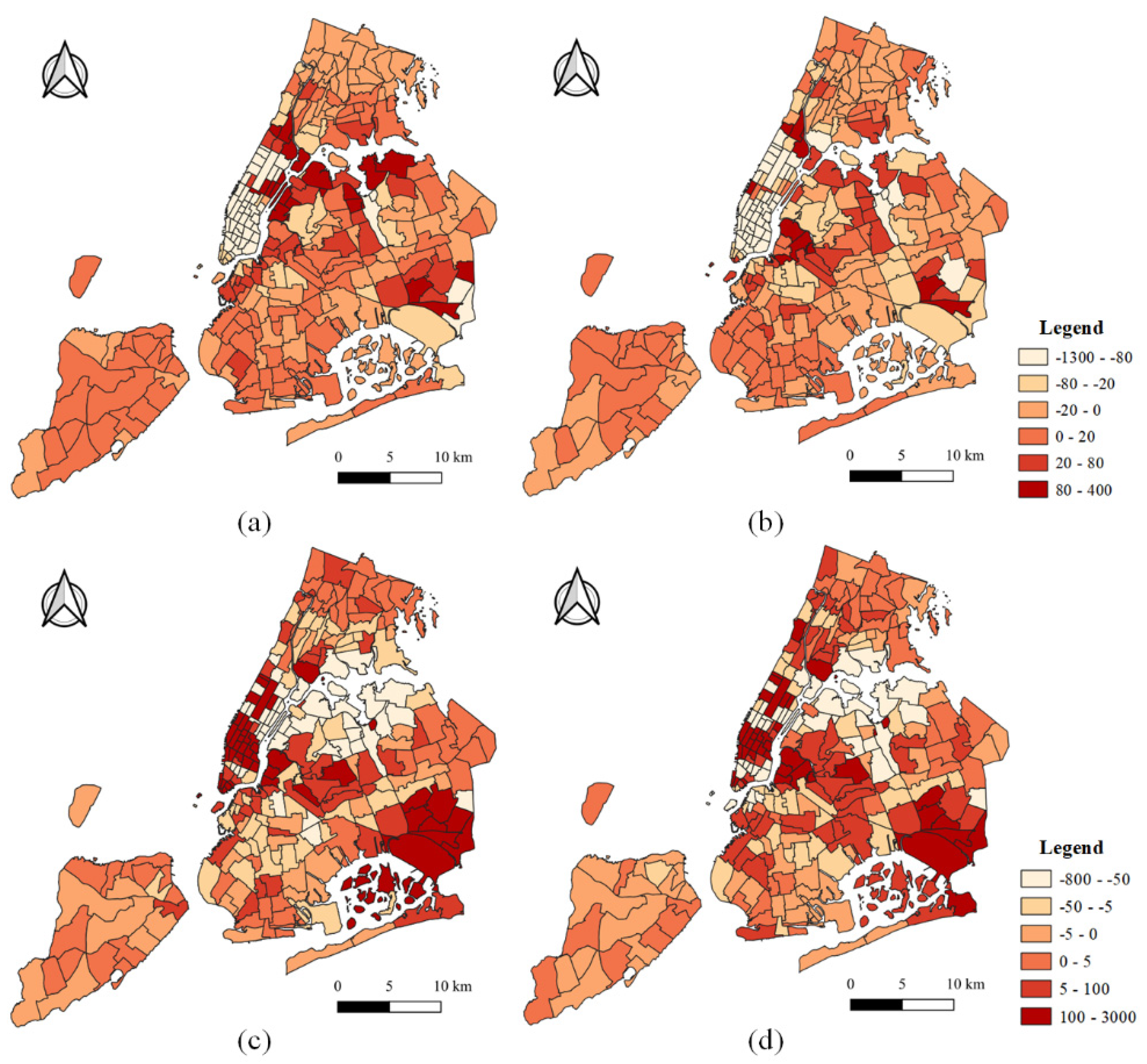
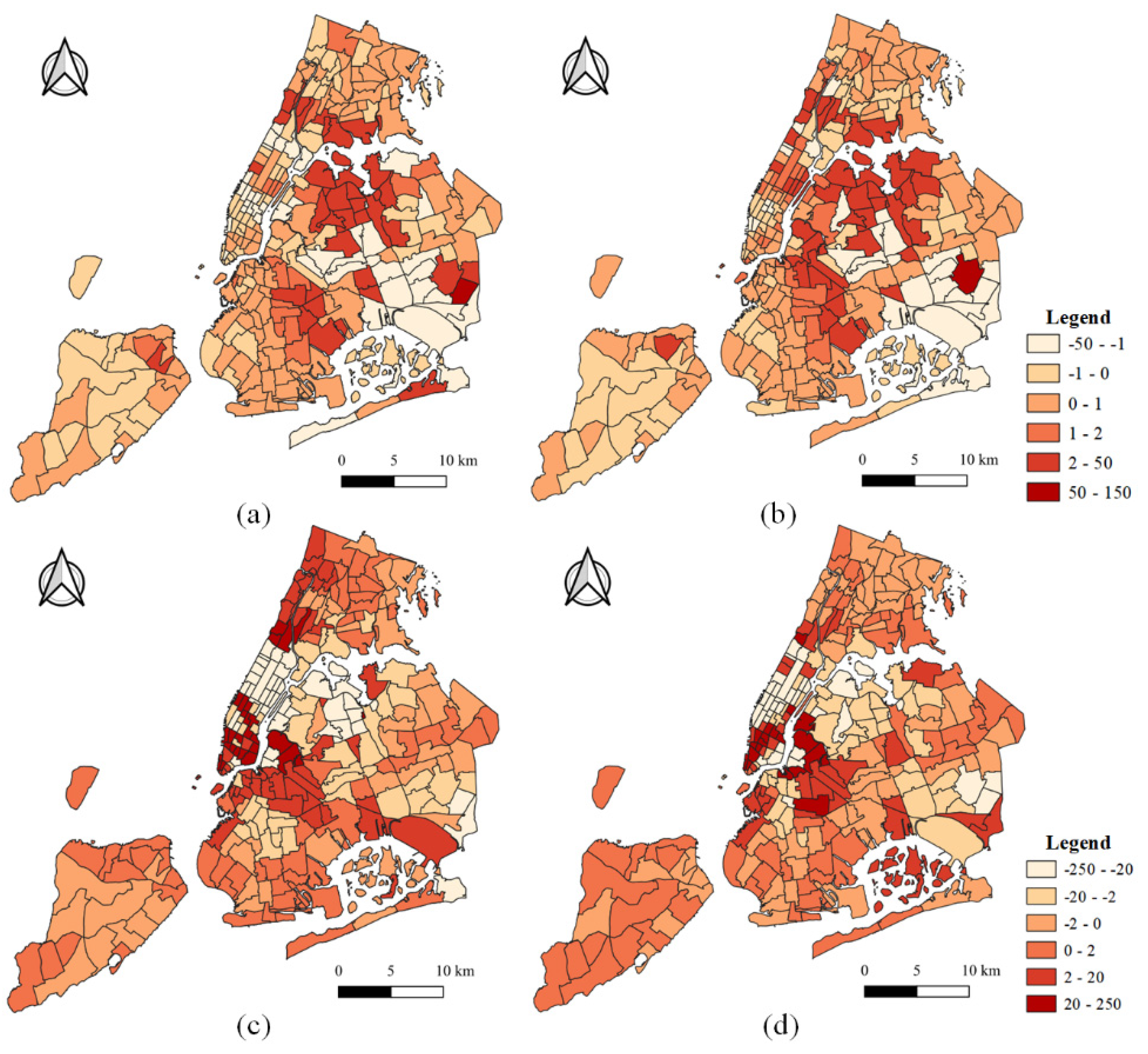
| Pick-up Datetime | Drop-off Datetime | Trip Distance (miles) | Travel Time (min) | Origin ID | Destination ID |
|---|---|---|---|---|---|
| 2016/6/6 0:00:00 | 2016/6/6 0:16:57 | 6.60 | 16.95 | 75 | 168 |
| 2016/6/6 0:00:01 | 2016/6/6 0:10:36 | 2.75 | 10.58 | 80 | 97 |
| 2016/6/6 0:00:03 | 2016/6/6 0:25:58 | 19.41 | 25.92 | 132 | 66 |
| 2016/6/6 0:00:03 | 2016/6/6 0:04:13 | 0.50 | 4.17 | 162 | 162 |
| 2016/6/6 0:00:04 | 2016/6/6 0:28:14 | 20.00 | 28.17 | 132 | 141 |
| … | … | … | … | … | … |
| Four ‘Ds’ | Variables | Descriptions | VIF | Methods |
|---|---|---|---|---|
| Density | Land use | |||
| Public | Police stations, fire stations, post offices, public telephone booths, libraries, etc. | 4.355 | Calculated using Equation (1) | |
| Catering | Regular restaurants, fast-food restaurants, cafes, pubs, bars, food courts, and biergartens | 8.470 | ||
| Leisure | Theaters, nightclubs, cinemas, parks, playgrounds, sports centers, ice rinks, etc. | 2.411 | ||
| Shopping | Supermarkets, bakeries, malls, department stores, and various types of shops | 7.223 | ||
| Tourism | Tourist information and destinations, such as tourist boards, museums, monuments, memorials, etc. | 1.760 | ||
| Education | Universities, schools, kindergartens, colleges, and public buildings | 2.887 | ||
| Health | Pharmacies, hospitals, medical practices, dentist’s practices, and veterinaries | 3.994 | ||
| Accommodation | Hotels, motels, hostels, etc. | 2.579 | ||
| Worship | Christian, Jewish, Muslim temples, etc. | 1.683 | ||
| Transport | ||||
| Taxi | Taxi ranks | 1.281 | Calculated using Equation (1) | |
| Bus | Bus stops | 2.101 | ||
| Railway | Rail, light rail, and subway stations | 2.340 | ||
| Parking | Parking sites and parking lots | 1.437 | ||
| Bicycle | Bicycle stops | 2.112 | ||
| Other | Airports and ferry terminals | 1.032 | ||
| Design | Traffic signal density | Traffic signals | 4.763 | Calculated using Equation (1) |
| Trunk road network density | Primary, secondary, and tertiary motorways | 4.071 | Calculated using Equation (2) | |
| Railway network density | Rail, light rail, and subway network. | 3.054 | ||
| Diversity | Land use entropy | Mixed degree of land use variables | 5.038 | Calculated using Equation (3) |
| Transport entropy | Mixed degree of transport variables | 5.038 | ||
| Destination accessibility | Road network accessibility | Accessibility of the road network based on travel time | 1.611 | Calculated using Equation (4) |
| Bus stop accessibility | Number of POIs within 400 m buffers around bus stops | 7.769 | Calculated using Equation (5) | |
| Railway station accessibility | Number of POIs within 800 m buffers around railway stations | 7.442 | ||
| Explanatory Variable | Weekday | Weekend | Extra Local Variation | ||
|---|---|---|---|---|---|
| Interquartile Range (GTWR) | 2 × SE (OLS) | Interquartile Range (GTWR) | 2 × SE (OLS) | ||
| Public | 5.483 | 0.688 | 5.417 | 0.612 | Yes |
| Leisure | 6.214 | 1.035 | 7.155 | 0.922 | Yes |
| Shopping | 1.295 | 0.139 | 1.471 | 0.123 | Yes |
| Tourism | 4.940 | 0.476 | 4.430 | 0.424 | Yes |
| Education | 5.840 | 1.144 | 6.153 | 1.018 | Yes |
| Health | 5.100 | 0.994 | 4.873 | 0.885 | Yes |
| Accommodation | 10.250 | 1.072 | 11.253 | 0.954 | Yes |
| Worship | 4.937 | 1.428 | 5.581 | 1.271 | Yes |
| Taxi | 64.000 | 5.295 | 64.000 | 4.711 | Yes |
| Bus | 1.465 | 0.374 | 1.792 | 0.333 | Yes |
| Railway | 13.720 | 2.265 | 16.266 | 2.016 | Yes |
| Parking | 17.160 | 1.696 | 15.740 | 1.510 | Yes |
| Bicycles | 1.410 | 0.129 | 1.459 | 0.115 | Yes |
| Other | 70.000 | 2.301 | 85.400 | 2.047 | Yes |
| Trunk road network density | 4.447 | 1.138 | 4.560 | 1.013 | Yes |
| Railway network density | 1.151 | 0.211 | 1.080 | 0.188 | Yes |
| Traffic signal density | 18.190 | 4.118 | 19.789 | 3.664 | Yes |
| Land use entropy | 30.695 | 5.382 | 42.179 | 4.832 | Yes |
| Transport entropy | 41.290 | 7.714 | 43.380 | 6.865 | Yes |
| Bus stop accessibility | 1.239 | 0.212 | 1.682 | 0.189 | Yes |
| Road network accessibility | 7.467 | 0.587 | 4.518 | 0.384 | Yes |
| Diagnostics | Weekdays | Weekends | ||||||
|---|---|---|---|---|---|---|---|---|
| OLS | GWR | TWR | GTWR | OLS | GWR | TWR | GTWR | |
| RSS | 67,202,330 | 35,416,732 | 41,422,998 | 1,470,040 | 53,226,703 | 31,243,642 | 31,452,719 | 813,424.9 |
| AIC | 76,489.920 | 72,659.310 | 73,570.170 | 53,850.090 | 75,018.290 | 71,870.390 | 71,841.180 | 51,362.880 |
| AICc | 76,490.100 | 72,942.010 | 73,763.410 | 56,371.620 | 75,018.470 | 72,155.900 | 72,044.570 | 58,536.110 |
| R2 | 0.525 | 0.750 | 0.707 | 0.990 | 0.545 | 0.733 | 0.731 | 0.993 |
| Adjusted R2 | 0.523 | 0.739 | 0.696 | 0.999 | 0.543 | 0.721 | 0.721 | 0.999 |
| Four ‘Ds’ | Explanatory Variable | Weekdays (Bandwidth = 0.502) | Weekends (Bandwidth = 0.495) |
|---|---|---|---|
| Density | Public | 0.23 | −0.40 |
| Leisure | −6.30 | 2.58 | |
| Shopping | −5.65 | −0.45 | |
| Tourism | −14.39 | 1.09 | |
| Education | −6.17 | 0.32 | |
| Health | 44.69 | −2.48 | |
| Accommodation | −13.50 | 3.69 | |
| Worship | −0.09 | 3.22 | |
| Taxi | 366.25 | 128.00 | |
| Bus | 0.23 | 0.43 | |
| Railway | 13.84 | −10.02 | |
| Parking | −79.86 | 0.66 | |
| Bicycles | −8.91 | −1.20 | |
| Other | −143.14 | −71.44 | |
| Design | Trunk road network density | 1.22 | −1.93 |
| Railway network density | 16.71 | −2.46 | |
| Traffic signal density | 0.30 | 0.42 | |
| Diversity | Land use entropy | −56.62 | −60.48 |
| Transport entropy | 36.48 | 36.82 | |
| Destination accessibility | Bus stop accessibility | 0.75 | 1.03 |
| Road network accessibility | −3.51 | −3.63 |
Publisher’s Note: MDPI stays neutral with regard to jurisdictional claims in published maps and institutional affiliations. |
© 2022 by the authors. Licensee MDPI, Basel, Switzerland. This article is an open access article distributed under the terms and conditions of the Creative Commons Attribution (CC BY) license (https://creativecommons.org/licenses/by/4.0/).
Share and Cite
Xie, C.; Yu, D.; Lin, C.; Zheng, X.; Peng, B. Exploring the Spatiotemporal Impacts of the Built Environment on Taxi Ridership Using Multisource Data. Sustainability 2022, 14, 6045. https://doi.org/10.3390/su14106045
Xie C, Yu D, Lin C, Zheng X, Peng B. Exploring the Spatiotemporal Impacts of the Built Environment on Taxi Ridership Using Multisource Data. Sustainability. 2022; 14(10):6045. https://doi.org/10.3390/su14106045
Chicago/Turabian StyleXie, Chen, Dexin Yu, Ciyun Lin, Xiaoyu Zheng, and Bo Peng. 2022. "Exploring the Spatiotemporal Impacts of the Built Environment on Taxi Ridership Using Multisource Data" Sustainability 14, no. 10: 6045. https://doi.org/10.3390/su14106045
APA StyleXie, C., Yu, D., Lin, C., Zheng, X., & Peng, B. (2022). Exploring the Spatiotemporal Impacts of the Built Environment on Taxi Ridership Using Multisource Data. Sustainability, 14(10), 6045. https://doi.org/10.3390/su14106045







